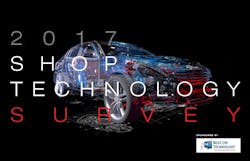The rapid advancement of technology is progressively changing the way those in the automotive industry operate—particularly those tasked with repairing and servicing vehicles. Ratchet+Wrench’s second annual Shop Technology Survey sought to evaluate how shops across the country have adjusted.
And, by our numbers, they’ve made great strides.
More shops utilize electronic management systems, digital inspection sheets and subscribe to repair information services today than when the first edition of this survey ran in 2016. More facilities have adopted streamlined processes with diagnostics—and many more have added to their arsenal of scan tools.
The pages that follow serve as a high-level overview of the data we uncovered through nearly 500 respondents to this year’s survey. (For the complete results, click here.) And, as you’ll see, those that have adapted already are reaping the rewards. Where do you stand?
The Typical Shop
In all, 446 industry professionals completed the Shop Technology Survey, and, while they were evenly dispersed across all U.S. markets, the majority of respondents followed a distinct demographic pattern that also closely aligns with our overall readership:
| Job Title | Shop Owner, executive or manager | 92% |
| Shop Type | Independent, single-location repair business | 91% |
| Work Type | General repair | 69% |
| Shop Size | 2,000-4,999 square feet | 39% |
| Number of Bays | 3-4 | 28% |
| Number of Lifts | 3-4 | 31% |
| Staff Size | 3-4 | 29% |
| Monthly Car Count | 50-149 | 41% |
| Annual Revenue | $1M-$2.49M | 25% |
| Average Repair Order | $200-399 | 49% |
| Repair-to-Maintenance Ratio | 30-40% maintenance/60-70% repair | 58% |
TECH: Front of the Shop
Much of the talk these days when it comes to industry technology centers on the advanced computer systems and capabilities of modern vehicles. Yet, on the shop level, it’s the front of the shop that has seen the largest changes.
According to our report, 81% of shops now use an electronic management system (up ever so slightly from 80% in 2016), and 35% use an electronic inspection sheet (3% higher than in 2016).
Is there an MSO advantage?
Multiple-Shop Operations (MSOs)
Independent, single locations
88%
Utilize an electronic management system
81%
94%
Utilize an electronic estimating system
81%
44%
Utilize an electronic inspection sheet
34%
63%
Utilize CSI software
33%
66%
Utilize CRM software
40%
Electronic Management Systems: A Key to Success?
Of the 82% of respondents who utilize an electronic management system, the majority tend to produce at a higher volume than shops that don't.
% of shops that use an electronic management system
% of shops that DON'T use an electronic management system
36%
Annual revenue above $1 million
12%
50%
Monthly car count above 150 vehicles/month
13%
47%
ARO above $400
34%
Electronic Inspection Sheet: A Key to Success?
Similar to with an electronic management system, higher-volume shops tend to use electronic inspection sheets. Although, a higher ARO may indicate the effectiveness of the software.
% of shops that use an electronic inspection sheet
% of shops that DON’T use an electronic inspection sheet
43%
Annual revenue above $1 million
24%
54%
Monthly car count above 150 vehicles/month
39%
52%
ARO above $400
42%
TECH: Back of the Shop
The rapid progression of in-vehicle technology has forced many in the industry to put a greater emphasis on repair information and advanced diagnostic work.
95% of respondents subscribe to a repair information service, and 99% own at least one diagnostic scan tool.
Total Number of Diagnostic Scan Tools |
Total Number of OEM Diagnostic Scan Tools |
Total Number of Aftermarket Diagnostic Scan Tools |
| None: 1% | None: 44% | None: 3% |
| 1-2: 32% | 1: 20% | 1: 14% |
| 3-4: 36% | 2: 13% | 2: 31% |
| 5 or more: 31% | 3 or more: 23% | 3 or more: 52% |
Is there an MSO advantage?
Multi-Shop Operations
Independent, single locations
Repair Information: A Key to Success?
80% of shops that subscribe to a repair information service have an ARO in the $200–$599 range; that number drops dramatically to 48% for those that don’t. ARO wasn’t the only KPI that varied drastically among those that do and don’t subscribe to repair information—annual revenue and monthly car count are also greatly affected.
Annual Revenue
Subscribe to repair information |
Don't subscribe to repair information |
|
| 11% | Annual revenue below $250,000 | 29% |
| 32% | Annual revenue about $1 million | 19% |
Monthly Car Count
Subscribe to repair information |
|
Don't subscribe to repair information |
| 12% | Monthly car count below 50 vehicles/month | 57% |
| 45% | Monthly car count above 150 vehicles per month | 10% |
TECH: Online Web Presence
The majority of our survey respondents have an active web presence:
- 73% have update their websites in the last two years.
- 51% use social media to promote their businesses at least on a weekly basis.
- 76% use Facebook to connect with customers.
Yet, there are still some shops struggling to get involved online:
- 17% still don’t have a website (a number that was identical in the 2016 survey)
- 25% don’t use any social media platforms (a 3% improvement from 2016)
Is there an MSO advantage?
The simple answer to this question is yes. But, independent shops are making rapid strides, and just since last year’s survey have shown a marked improvement.
Have a Website
Utilize Social Media
The Investment
One of the largest hurdles for shops to overcome in adopting new shop technology can be the considerable investment. Yet, the majority of our respondents have made that leap.
82% say they provide tech/tools to their teams.
Of those …
93%: diagnostic scan tools and data subscriptions
11%: all tools and equipment
Annual technology, tools and equipment investment
- Less than 1%: 3%
- 1–5%: 29%
- 6–10%: 33%
- 11–15%: 9%
- 16–20%: 4%
- 21% or more: 1%
- No budget: 22%
*% of shop’s annual revenue
Training and Certifications
78% of all respondents participate in industry training.
58% have at least one tech with an ASE designation
21% have earned ASE’s Blue Seal status
Does industry training lead to a greater emphasis on advanced technology?
Shops that have earned Blue Seal certification
Shops not in the ASE program
88%
Participate in non-ASE industry training
56%
94%
Provide various tools, technology or equipment for technicians
82%
91%
Utilize an electronic management system
64%
91%
Utilize an electronic estimating system
68%
41%
Utilize an electronic inspection sheet
22%
51%
Utilize CSI software
20%
60%
Utilize CRM software
29%
52%
Utilize KPI software
19%
97%
Subscribe to a repair information service
74%
87%
Have access to OEM repair information
82%
63%
Use at least one OEM scan tool
48%
66%
Have three or more aftermarket scan tools
35%
97%
Have a website
69%
91%
Utilize social media
65%
Telematics
Only 6% of all respondents offer telematics services, which actually came in slightly below last year’s number (8%). The trend is negligible, but it does demonstrate that, as this form of technology advances, independent shops haven’t found ways to work it into their service offerings—yet.
The Services:
Of the 6% that offer telematics devices:
- 52% either install, program and repair devices or educate customers about the technology.
- 36% do so through a third-party aftermarket product (Mechanic Advisor being a popular choice).
- 32% use it to regularly update customers with service reminders
The Shops:
It shouldn’t come as a surprise that those offering telematics services tend to be more advanced in terms of other technology as well.
96% make technology and tools purchses for their techs, and roughly 48% have a tech/tool budget greater than 6% of their annual revenues.
Here is a brief snapshot of what these facilities look like:
- Utilize an Electronic Management System: 92%
- Utilize an Electronic Estimating System: 88%
- Utilize Digital inspections: 56%
- Subscribe to an Information Service: 100%
- Have Access to OEM Repair Information: 96%
- Have Diagnostic Scan Tools: 100%
- Have at least three Diagnostic Scan Tools: 84%
- Have Five or More Scan Tools: 52%
- Have at Least One OEM Scan Tool: 88% have OEM scan tool(s)
GET THE COMPLETE RESULTS
To purchase the complete survey results, click here.
About the Author

Bryce Evans
Bryce Evans is the vice president of content at 10 Missions Media, overseeing an award-winning team that produces FenderBender, Ratchet+Wrench and NOLN.
